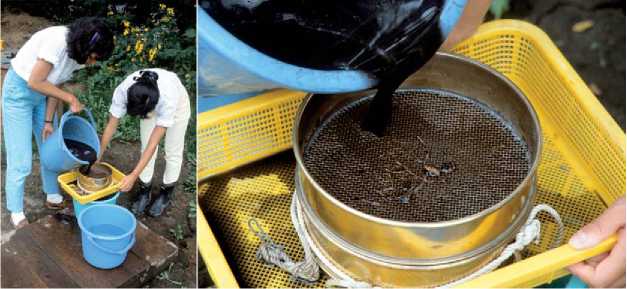Analysis of light fractions follows a standard procedure at each lab in order for data to be comparable. Methods may vary depending on the lab and the samples (samples from Ontario have large quantities of wood charcoal, maize cob fragments, and kernels while samples from China often have only small seeds, but the techniques are all designed for efficiency and accuracy). Seeds vary in size and are mixed with other debris so preparing a sample so that it is easier to view and quantify is important. In the lab, samples are weighed and then passed through a series of nested geological sieves normally of the following mesh sizes: 6.35, 4.00, 2.38, 2.00, 1.41, 1.00, 0.71, 0.42, and 0.21 mm. The number of screens can vary depending on the sample size (fewer screens for smaller samples), but this is typical for a 20 g sample. The analyst can microscopically scan particles of roughly the same size making observations consistent. Seeds of the same type, because they are roughly the same size, will be separated to a great extent too. Weights of each of the portions are recorded. The first sample weight and the fraction weights are not used in the final tabulations but are used to audit the analysis. The fractions above the 2.38 or 2.00 mm screen are

Figure 1 The bucket decanting flotation method.
Separated entirely into their constituent components, which may include wood charcoal, nutshell, large crop seeds (maize, wheat, barley etc.), unidentified plant remains, bone, stone flakes, and uncarbonized organic material such as rootlets. Seeds of wild plants are usually found in the fractions smaller than 2.38 mm, and their weight is usually quite small. Each of the larger components is weighed and the seeds counted. Mineral and uncarbonized organic material are not included in the final results that are limited to archaeologically significant material. Each of the other components is reported as a percentage of the total component weight and density (g/l of soil).
Only carbonized seeds or items for further study are removed from the smaller material. Watchmakers’ tweezers, fine brushes, and dissecting needles all can be used to extract delicate seeds from the sample. Some analysts count the seeds but do not separate them. This may not be a problem but the author prefers to store the seeds and other interesting specimens separately by type in gelatin capsules so they are easier to check and reanalyze. The seeds are weighed together as a component. The percentage summaries of the gross composition of the samples are based on the material larger than 2.00 mm. The author has found that the smaller fragmentary material is easily misidentified and it may take hours or days to split (with a wide margin of error) the smaller material into wood charcoal, nutshell and so on. Given the available resources of most labs, separating an entire sample into its constituent components is neither accurate nor efficient.
Data are best recorded in a computerized database. In the lab data are first recorded on a hard copy of the same form used for data entry on the computer. Any relational database will suffice. Retrieval of samples fitting particular criteria is fast and accurate and tabular summaries of data can be quickly achieved.




 World History
World History









